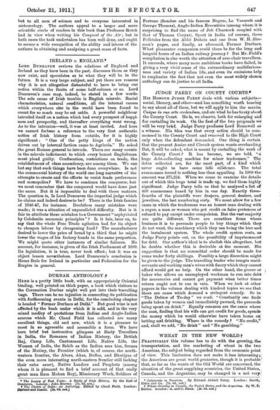CHARTS OF THE ATMOSPHERE FOR AIRMEN AND OTHERS.*
ALL experience gained in actual mechanical flight tends to demonstrate the importance attaching to a more thorough knowledge of atmospheric phenomena. Much has been done during recent years in the way of experimental research into actual movements of the air at varying altitudes and the characteristic features of aerial currents and winds. An ex- cellent summary of facts as ascertained up to date was prepared by Dr. Shaw and embodied in the first series of reports made by the British Aeronautics Committee appointed by the • Charts gins Atmosphere. By A. Lawrence notch and Andrew H. Palmer. Leaden: CkApman and Hall. [Be. 6c1., set] Government. Anyone who undertakes the study of Dr. Shaw's Paper must be impressed by the fact that stream-line motions in the atmosphere are Moat irregular ; arid, judged by our present state of knowledge, they are often most erratic in character. Airmen when making flights not infrequently ex- perience Sudden and violent changes in the character of the air-currents through which they are passing; and because the relative velocities of flying Machines and that of the wind currents through which they pass practically govern the lifting power and stability of every flying machine which is heavier than air, it follows that when such sudden changes are en- countered an airman needs to exercise all poisible skill and resourcefulness in order to prevent disaster. Sometimes he fails, and failure is often fatal. It is easy to understand that an airman who undertakes to crest; the Pyrenees, as was done by Vedrinee, or who has to pads flirt:nigh a Strong wind at a place where it meets the crest of a nithiritain range or a chain of hills before be tan cross the suittaft *est face dangerOugi eddies and itctien changes of direotion and velocity hi the air-currents caused by solid obstructions against which the wprde impinge. It IS also a matterof 6ornmon experiencethat bymere Change in eleVation an airman nartyescariefromanadverse aerial current and may attain conditions which favour his advance. These, however, are amongst the simplest Of the varied and complicated phenomena of the atmosphere. Airmen tell us of dangerous encounters with what they style "holes in the air" in other words, regions Where the conditions of relative motion are such that a machine which has been proceeding steadily at a fairly uniform height suddenly drops through a Considerable distance, and thus severely and almost instantaneously puts a strain on the nerves as well as the alertness of the pilot in Managing his machine.
Amongst experimentalists and observers who have contri- buted greatly to the elucidation of these difficult problems and the compilation of data which are already of great im- portanee to the progress of aerial navigation Professor Rotch (of the Blue Hill Meteorological Observatory) has become distinguished. His little book entitled The Conquest of the Air was noticed in these pages some time ago. Professor Rotch has now produced a second volume, having for his colleague in that production Mr. Andrew H. Palmer. The avowed object of this book is to extend into the "overlying ocean of air" work which " Lieutenant Maury did fifty years ago for surface winds and ocean currents " ; and this, as Professor Rotch well says, "is the more necessary since the whole aerial ocean is subject to stronger commotions than even the surface of the aqueous ocean, and is navigable throughout a depth equal to that of the latter." A series of twenty-four charts has been prepared specially adapted to the use of airmen. In these the known atmospheric phenomena occurring over portions of the United States and the Atlantic Ocean are recorded graphically, and the hope is expressed that this undertaking will be extended by other workers to other parts of the globe. Everyone who studies these charts and the brief descriptions appended thereto will unite in the desire that this hope may be realized. In dealing with such records a graphic method has many advantages, especially as it enables non-technical persons to master facts and principles. It is neither possible nor is it necessary to describe the charts in detail ; each of them as it stands is a condensed summary of observed phenomena ; the descriptions, although quite clear, are very, brief. One can find therein facts as to the variation of temperatures with height above sea-level for different lati- tudes, the characteristics of clouds at different heights, the average barometric pressure as well as the average and maximum observed wind velocities and wind pressures, and the hourly variations in wind velocities observed simul- taneously for varying altitudes. The " frequency " of winds for constant velocities is dealt with on the basis of observa- tions made at Blue Hill, and certain deductions of a practical nature are made therefrom. It is considered, for example, that "the winds suited for aerial navigation which prevail in New England more than half the time at 1,000 feet occur very rarely at 10,000 feet; and that gales strong enough to prevent airship manoeuvres are very much more frequent. at 10,000 feet than at 1,000 feet." In the circumstance's Obviously the life of a New England airman is not likely to b a happy one. All the same it remains trim that the feat brought together in this volume are of essential interest ant . importance, not Only to those who practise aerial navigation; bzia to all men of science and to everyone interested in meteorology. The authors appeal to a larger and more scientific circle of readers in this book than Professor Rotch had in view when -writing his Conquest of the Air ; but in both cases the task undertaken has been well done, and ought to secure a wide recognition of the ability and labour of the anthers in obtaining and analysing a great mass of facts.















































 Previous page
Previous page